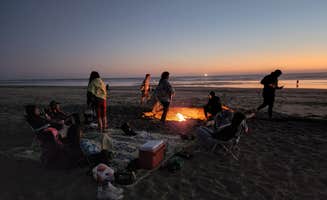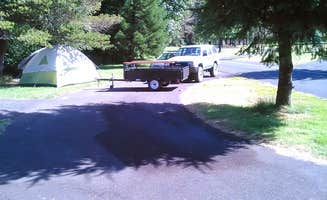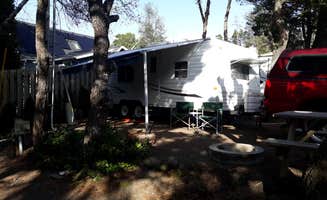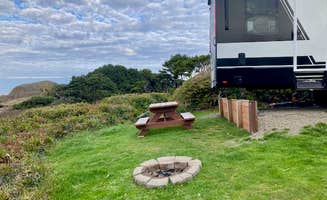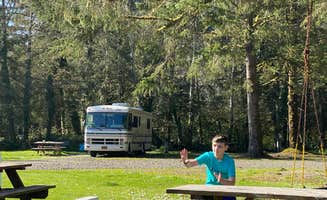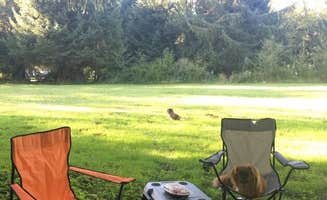The central Oregon coast near Agate Beach offers camping options within 10 miles of the Newport shoreline. Forest Road 51 near Beaver Creek provides the only dispersed camping in the immediate area, with a narrow gravel road leading to 3-4 primitive sites lacking facilities. Most campgrounds in the region remain open year-round, with summer high season bringing fog-shrouded mornings that typically burn off by midday, while winter camping faces consistent rainfall averaging 10-15 inches monthly between November and February.
What to do
Fossil hunting at Beverly Beach: The beach areas directly accessible from Beverly Beach State Park Campground contain abundant marine fossils embedded in rock formations. "Nearly every rock and cliff face is littered with marine fossils of varying types and sizes and you can often find individual fossilized shells that can be collected," notes one visitor. The beach also provides opportunities for agate hunting, particularly following coastal storms.
Visit Newport Harbor: Port of Newport RV Park & Marina offers proximity to waterfront activities with crabbing opportunities directly from the marina. "You are right off the marina and could crab and fish to your hearts content," states one camper. The park's location places guests within walking distance of Rogue Brewery headquarters and a short drive from the Oregon Coast Aquarium.
Explore Beaver Creek: Forest Road 51 near Beaver Creek provides a quieter alternative to coastal camping. "Beaver creek area was really cool, but the main trail was flooded out when I visited. I did see about 5 beavers close to the road though, so that was sweet," reports one camper. The surrounding forest offers wildlife viewing opportunities and hiking trails, though seasonal flooding may affect accessibility.
What campers like
Easy beach access: Beachside State Recreation Site provides direct pathways to the shoreline with multiple entry points. "Spot 62 had a secret access to the beach that looks to be one of two away from the general access," shares one camper. The park's design places many sites within a short walk of the ocean while maintaining tree cover for wind protection.
Coastal forest settings: Many campgrounds near Agate Beach feature wooded sites that provide natural privacy screens and protection from coastal winds. At Devil's Lake State Recreation Area, "Campground was tidy, quiet, and fairly private from our neighbors. Camp host left a small bundle of wood for us when we arrived which was nice." The combination of forest and beach access creates camping environments that buffer road noise and provide shade during warmer months.
Oceanfront views: Several campgrounds offer sites with direct ocean views. At Tillicum Beach Campground, "Sites here are $34 for non-hookup sites, and if you can get one of the prime ocean view ones, it's well worth it." These premium locations allow campers to observe tides, storms, and sunsets directly from their sites without relocating to observation points.
What you should know
Limited dispersed options: Unlike inland areas, the coastal region near Agate Beach offers minimal free camping. "There is almost nowhere to stay in the Newport/Oregon Coast areas, so this spot was a life saver! After you hit the dirt road, there are a few good but smaller pull off spots and a few bigger ones," notes a visitor to Forest Road 51. Arrive early during summer months as these limited sites fill quickly.
Mosquito presence: Several campgrounds report seasonal mosquito populations, particularly at sites farther from direct ocean exposure. "We camped here in May. It had little privacy and a lot of mosquitoes," reports one camper at South Beach State Park. Bring appropriate repellent during summer months, especially for evening outdoor activities.
Reservation requirements: Most established campgrounds require advance bookings during peak summer season. Winter and shoulder season camping provides more flexibility for last-minute trips, though some facilities reduce operations during off-peak months. Sites with ocean views generally book 6-9 months in advance for summer periods.
Tips for camping with families
Educational programs: Several state parks offer structured activities for children. At South Beach State Park, "Nice grounds, several bathrooms. Near a great walk path (paved) and easy access to the beach. This is a great campground and very kid friendly!!" The ranger-led programs typically operate during summer months and focus on coastal ecology, marine life, and local history.
Protected play areas: Thousand Trails Whalers Rest provides family-focused recreation options away from direct beach exposure. "The pool, mini golf, play ground and other fun games. I was disappointed with the quality of the sites including the size," explains one visitor. These sheltered activity zones provide alternatives during inclement weather or when beaches experience unsafe conditions.
Beach safety awareness: Coastal camping requires heightened attention to tides, currents, and weather conditions. Campgrounds with direct beach access generally post tide tables and safety information at trail access points. Visitors should check daily conditions before beach activities, as winter king tides and summer sneaker waves pose risks regardless of general weather conditions.
Tips from RVers
Site selection strategies: Many coastal campgrounds feature tight spacing and challenging access angles. "Many sites you will need to be skilled at leaving your trailer. Also be very skilled at backing in as they can be at less then ideal angles," advises an RVer at Thousand Trails Whalers Rest. Larger rigs should prioritize pull-through sites or research specific site dimensions before booking.
Utility considerations: Full-hookup sites typically command premium prices at coastal campgrounds. "We stayed in an ADA site during the week in mid July. It was nice flat ground and easy access to the beach through the campground," notes a visitor to Beverly Beach State Park. RVers requiring consistent power should verify electrical capacity matches their needs, as some parks offer limited 50-amp service.
Wind protection: Coastal camping exposes RVs to consistent winds that can affect awnings, stabilization, and comfort. Sites with natural windbreaks through forest cover or terrain features provide advantages over direct oceanfront exposure during stormy periods. Position RVs with doors and primary windows away from prevailing wind direction when possible.



